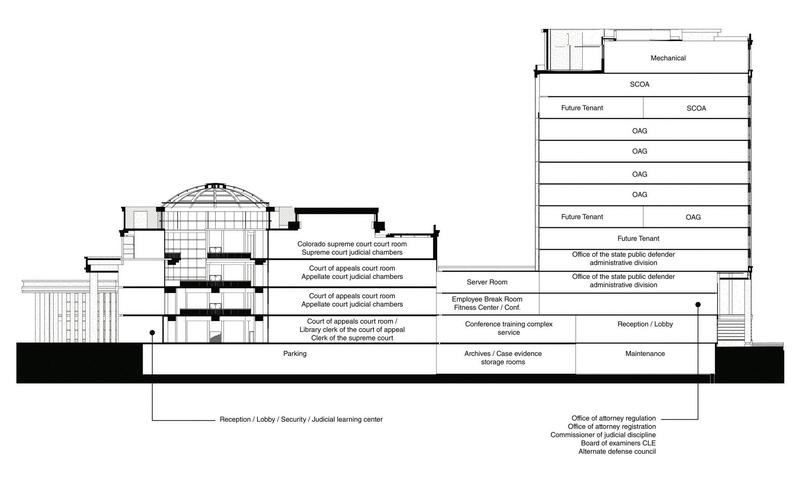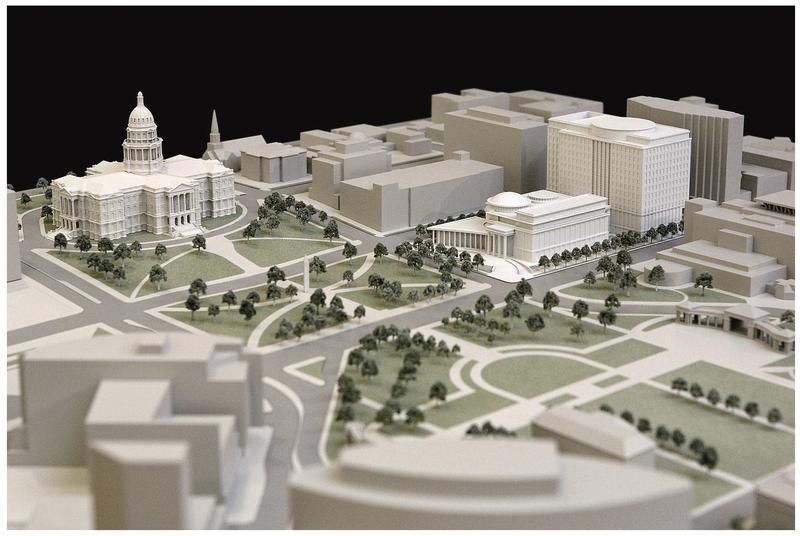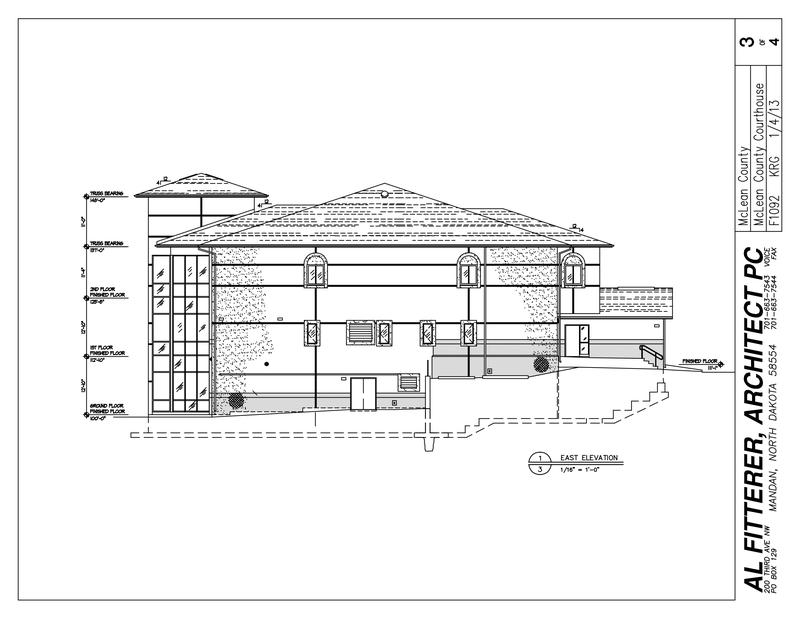For a discussion about symbolism and functionality in design, see Design and Image.
The design phase for a judicial facility may be quite lengthy and complex depending on the nature of the project. Designing for the renovation of a single floor of an otherwise workable building might be a relatively brief process. Designing for the renovation of a large and complex building or designing a new facility can take as long as a year. Complex building projects provide numerous opportunities for omissions in communication, disagreements or changes with regard to proposed operations, and delays. Delay often affects project construction budgets. Good project management ensures proper communication to achieve consensus and facilitates an effective and efficient design process.
There are three major phases to the design process: (1) Schematic Design, (2) Design Development, and (3) Construction Documents.
Schematic Design
 |
|
Stacking Diagram - Ralph L. Carr Colorado Judicial Complex |
An early element of schematic design is sometimes referred to as conceptual design. This phase generates a general concept for the building. The process starts with blocking and stacking exercises--establishing the basic footprints of individual floors and stacking the floors vertically. Typically, large blocks of space with relatively little interior detail are shown in this phase. Some interior detail probably would be shown for courtrooms and specific courtroom support elements, as the arrangement of courtroom suites typically determines the footprint and structure of a court floor, and, to some extent, the overall concept of the building. Schematic design emphasizes site orientation and general building elevations, vehicular and pedestrian access, links to other functions and facilities, internal circulation, structural considerations, and location of and general approach to major mechanical systems.
In this phase, a solid concept of the building first begins to emerge. On a new construction project, the architectural team might generate several alternative concepts, each characterizing a different vision of the building. Each would respond to the program in terms of general space allocations, but might locate and configure the spaces in very different ways. There are many variations in organizing a court building, but three general options include: a low‑rise facility with very large floor plates, a mid-rise facility with smaller floor plates, and a high-rise facility with even smaller areas on any given floor. Building profiles range from very low and massive to very tall and slender, and articulation varies in an equally dramatic fashion. The selected concept could represent a clear choice among the three, or could contain characteristics of more than one alternative. The overall design image and issues such as orientation, compatibility, facade, articulation, and projected costs would be weighed against operational considerations in arriving at a preferred concept.
That concept, along with some preliminary analyses of exterior material options and structural, mechanical, electrical, and plumbing systems, would be documented, typically in one-eighth-inch scale drawings, at the conclusion of the schematic design phase.
 |
|
Ariel Model - Ralph L. Carr Colorado Judicial Complex |
In many instances, it is desirable to use both scale models and full-scale mock-ups of various aspects of the facility to achieve proper relationships and to view the design better. This is particularly the case with the design of the courtroom, where the use of full-scale mock-ups has become common and is recommended.
The detail included in a schematic design package varies with the particular project and design approach. Too much specificity, too soon, could be costly. Design processes are dynamic. Operational approaches sometime change as individuals leave or as more time is devoted to issues. Changes that occur early in the design process are relatively easy to manage; substantial changes later in the process inevitably involve more extensive redesign and expense. Sufficient time should be devoted to the schematic design phase to ensure substantial agreement on key issues and specific design solutions.
Design Development
This phase develops and refines the schematic design concepts. More detailed exploration of the preliminary design elements is provided, and additional design elements are analyzed in this phase. Design Development includes detailed analysis of:
- Foundation and structural components
- Roofing systems and waterproofing elements
- Mechanical, electrical, plumbing, and fire suppression systems
- Exterior articulation and fenestration
- Exterior material and color selections
- Exterior site and landscaping elements
- Interior floor plans including
- Circulation and core elements, (lobbies, elevators, stairs, toilets
- Service elements, (telephone/electrical and equipment rooms, janitor closets)
- Individual component design, (courtrooms, holding units, offices, workstations)
- Interior furniture systems
- Interior finishes, furnishings, and materials
- Special security, telecommunication, and computer equipment
 |
|
McLean County, North Dakota Courthouse Drawing |
Although not exhaustive, this list illustrates the levels of design detail that are used. Major design and operating choices give way to detailed examinations. Exterior elements, floor plans, systems, materials, and finishes begin to interrelate. The Design Development phase typically takes several months. As in planning and schematic design, a good deal of interaction takes place among the design team, advisory committee, and facility users, as ideas are analyzed, refined, communicated, and modified. Although the precise product of design development will vary somewhat from project to project, the report documentation will typically include one-quarter‑inch scale drawings of all design elements with fairly comprehensive outlines of specifications sufficient to develop a detailed cost estimate and permit the development of construction documents and bid packages.
Final design decisions should be completed by this point, as major changes after this point are very costly. Later, as actual construction commences, significant changes will involve not only redesign costs but duplicate construction costs as well. Typically, the only design changes considered after this phase involve final coordination of design elements.
Construction Documents
The construction document phase places all of the planning and design decisions into a single set of detailed drawings and specifications. Detailed drawings, sometimes still referred to as blueprints, are accompanied by equally detailed narratives specifying exact structures, systems, materials, finishes, and so on. For example, the carpet described in general terms during design development is now described in detail with respect to yarn weight, backing, thickness, color, and density. This extensive package of detailed drawings and detailed specifications is made available to contractors and specialty subcontractors who want to bid on the building project. The construction documents describe all parts of the project and provide the legal documentation with which the contractor must comply. The documents, perhaps with some modification during the bidding process, thus become the basis for setting final construction costs and for implementing actual construction.
Design documentation coordination involves the integration of drawings and specifications within and among the various disciplines. For instance, the structural framing, mechanical duct work, plumbing, lights, electrical conduit, fire sprinklers, and other systems must properly interrelate. Many construction problems result from location conflicts among pipes, ducts, and beams.
Compliance with applicable codes should be reviewed throughout this, and earlier, phases. Ideally, compliance with all building codes and local ordinances should be verified throughout the design phases. If sufficient review by building officials has occurred during schematic design and design development, review during this phase can be relatively routine. If this early compliance review has not been conducted, extensive review at this late stage may compel significant redesign as detailed plans and specifications are reviewed and understood.
As the design documents near completion, a final cost estimate should be prepared based on final building areas, detailed drawings, and detailed specifications. Most complex projects will employ a cost estimating firm that specializes in providing costs estimates. Any projected costs in excess of the project budget should be addressed before bidding. Depending on the final budget estimates, bid alternates may be developed to stay within or fully utilize the project budget. Bid alternatives describe options, such as finishes or features, which the owner may wish to accept.
A final important aspect of this phase is the development of general and supplemental conditions (including special insurance provisions) to the general contract, and the development of the bidding process and written instructions. The design team will typically work closely with the client and project manager in preparing for the bidding process.
